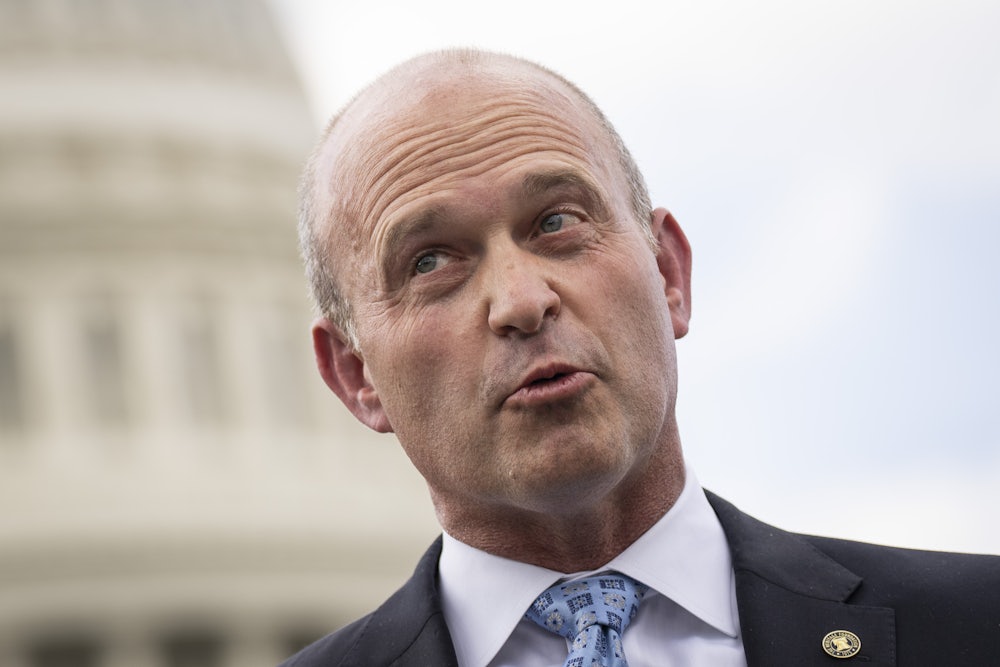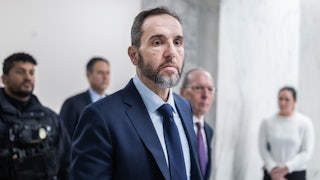If there’s anyone to thank for making Project 2025 famous—after actress Taraji P. Henson—it’s Kevin Roberts. For months, the blueprint for a potential Trump presidency, which was crafted by more than 100 conservative groups corralled by the Heritage Foundation, has been an undercurrent in the political conversation. But over the last week or so, the threat of Project 2025 has broken through the mainstream. Henson warned about it while hosting the BET Awards, and a few days later Roberts, the president of Heritage, showed why Henson and so many others are now sounding the alarm. “We are in the process of the second American Revolution, which will remain bloodless—if the left allows it to be,” he said on a far-right podcast.
“Look at America under the ruling and cultural elite today,” Roberts writes in the foreword to Mandate for Leadership, the guiding framework for Project 2025. “Inflation is ravaging family budgets, drug overdose deaths continue to escalate, and children suffer the toxic normalization of transgenderism with drag queens and pornography invading their school libraries.” Even with the increased attention on Project 2025 recently, the document’s fearmongering over pornography has been overlooked, perhaps because it could seem like a non sequitur alongside the economy and the overdose epidemic. But there it is, on the document’s first page, one item in a litany of signs of the destruction of American values. And several pages later, it says outright, “Pornography should be outlawed.”
The prominence of pornography in Project 2025 is no mistake, of course; it’s absolutely core to the authors’ agenda for Trump. The attack on porn is inseparable from the attacks on abortion and contraception, on marriage equality and trans rights, and of course on drag queens and library books—all of which, they believe, threaten the straight, married family as the natural bedrock of society. All of these threats, to them, constitute pornography. By calling on the president to outlaw porn, they’re calling for the eradication of all these imagined enemies of the family.
Though Project 2025 does not define “pornography,” their concern clearly extends beyond porn itself. Pornography, according to the Mandate, is responsible for the “normalization” of non-normative gender expression and identity among young people—what the right often calls “gender ideology.” Pornography could be anything that contributes to that purported normalization. “Pornography,” Roberts continues, is “manifested today in the omnipresent propagation of transgender ideology and sexualization of children.” And how should it be outlawed? “The people who produce and distribute it should be imprisoned. Educators and public librarians who purvey it should be classed as registered sex offenders. And telecommunications and technology firms that facilitate its spread should be shuttered.” Project 2025 is not targeting “pornography” as something that’s harmful to children per se, but rather redefining anything concerning sexuality and gender that they say is harmful to children as pornography.
Some of the groups behind Project 2025, including Heritage, have had their own anti-“pornography” drives for years. The “Promise to America’s Children” campaign was launched in 2021, tied to the Equality Act and led by three Project 2025 groups: Heritage, the Family Policy Alliance, and Alliance Defending Freedom. “America’s children are increasingly exposed to adult themes and sexual images at younger and younger ages,” Emilie Kao, director for Heritage’s DeVos Center for Religion and Civil Society, said in a campaign press release. “It’s not just entertainment and broader culture. Too many government initiatives push graphic information about sex and abortion and promote destructive ideas about gender identity. Cementing gender ideology into law through the Equality Act will endanger children’s physical, emotional, and mental health as well as undermine parental rights.” By parental rights, they mean the rights of parents to restrict access to such information and ideas. The “Promise” campaign pushed laws that would ban young trans people’s participation in sports, as well as block their access to hormones and puberty blockers, and to regard their supportive parents and educators as engaging in child abuse.
The Promise campaign didn’t only target lawmakers. It also came with a guide for parents, warning that their children were being exposed to “a radical sexual ideology,” as evidenced in comprehensive sex education, curricula on LGBTQ history, and policies barring discrimination against LGBTQ students and school staff. All of this is collapsed into a dangerous “ideology” or agenda. “The promise begins with the pledge to protect children’s minds from graphic sexual content and the sexual orientation and gender identity agenda in the classroom,” announced Heritage. That slip from “graphic sexual content” to “the sexual orientation and gender identity agenda” is telling, and a sign of more to come.
The “Promise to America’s Children” campaign is not only an American project. It’s one facet of a global effort to roll back progress around gender and sexuality, as seen in Russia and Hungary and other countries that have marshaled protecting “children” and “families” in service of eroding civil rights for women and LGBTQ people. Despite homosexuality being decriminalized in Russia in 1993, the Russian Supreme Court last year decreed that the “international LGBT movement” is an “extremist organization.” Earlier this year, under Russia’s new so-called “propaganda law,” employees at queer and drag venues were charged with “promoting nontraditional sexual relationships and preferences” and “promoting nontraditional sexual relations among the visitors of the bar.” Others have been convicted under the law for wearing frog-shaped rainbow earrings and for posting a photo of a Pride flag online. Such policing is part of what Putin has called defending “traditional family values”—a framing that borrows from conservatives in the United States.
That exchange goes both ways: Kevin Roberts has had a receptive audience with Viktor Orbán in Hungary. “We must not give up on our core values: #family, #sovereignty, #liberty and #faith. This was at the heart of our discussion with @Heritage president @KevinRobertsTX,” the prime minister posted to X in November 2022. Roberts replied, “It was an honor, @PM_ViktorOrban, to meet with you. One thing is clear from visiting Hungary and from being involved in current policy and cultural debates in America: the world needs a movement that fights for Truth, for tradition, for families, and for the average person.” There is much in Project 2025’s vision of “tradition” and “families” that evokes Orbán’s rule, such as Hungary’s own anti-LGBT propaganda law and his anti-abortion laws.
Behind all this is what philosopher Judith Butler calls anti-gender ideology and movements, which is how we should understand Project 2025’s anti-pornography rhetoric. It’s a transnational movement, fueling and also fueled by the reassertion of patriarchal order, of a return to normative sex and gender roles, and of ordering the world by sex and gender hierarchies. Gender in this movement has come to be regarded as a code, as Butler has described it—for pedophilia, for the destruction of the family, “a plot by urban elites to impose their beliefs on ‘real’ people,” a threat to civilization, a threat to masculinity. When the fight is defined that way, a fight to save not just children and families but society and civilization, nearly any crackdown can be justified. And if you look to the work of its constitutive groups, Project 2025 is already here, depending on where you live: in Alabama, one of eight states that forces schools to out trans students; in Florida, one of more than a dozen states that bars or highly restricts discussions of LGBTQ people or issues in the classroom; or in Texas, one of the two dozen states that ban hormones and puberty blockers for trans and gender-nonconforming youth. These kids already live under the conservative vision of “protecting children.” Project 2025 is proof that they want to finish the job, to make everyone in the United States live subject to their rules.








